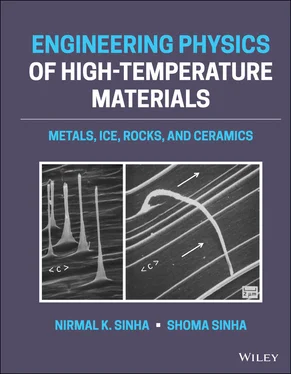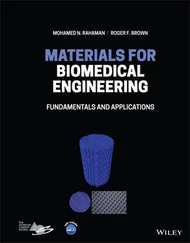Nirmal K. Sinha - Engineering Physics of High-Temperature Materials
Здесь есть возможность читать онлайн «Nirmal K. Sinha - Engineering Physics of High-Temperature Materials» — ознакомительный отрывок электронной книги совершенно бесплатно, а после прочтения отрывка купить полную версию. В некоторых случаях можно слушать аудио, скачать через торрент в формате fb2 и присутствует краткое содержание. Жанр: unrecognised, на английском языке. Описание произведения, (предисловие) а так же отзывы посетителей доступны на портале библиотеки ЛибКат.
- Название:Engineering Physics of High-Temperature Materials
- Автор:
- Жанр:
- Год:неизвестен
- ISBN:нет данных
- Рейтинг книги:3 / 5. Голосов: 1
-
Избранное:Добавить в избранное
- Отзывы:
-
Ваша оценка:
- 60
- 1
- 2
- 3
- 4
- 5
Engineering Physics of High-Temperature Materials: краткое содержание, описание и аннотация
Предлагаем к чтению аннотацию, описание, краткое содержание или предисловие (зависит от того, что написал сам автор книги «Engineering Physics of High-Temperature Materials»). Если вы не нашли необходимую информацию о книге — напишите в комментариях, мы постараемся отыскать её.
Discover a comprehensive exploration of high temperature materials written by leading materials scientists Engineering Physics of High-Temperature Materials: Metals, Ice, Rocks, and Ceramics
Engineering Physics of High-Temperature Materials (EPHTM)
Engineering Physics of High-Temperature Materials
Engineering Physics of High-Temperature Materials: Metals, Ice, Rocks, and Ceramics
Engineering Physics of High-Temperature Materials — читать онлайн ознакомительный отрывок
Ниже представлен текст книги, разбитый по страницам. Система сохранения места последней прочитанной страницы, позволяет с удобством читать онлайн бесплатно книгу «Engineering Physics of High-Temperature Materials», без необходимости каждый раз заново искать на чём Вы остановились. Поставьте закладку, и сможете в любой момент перейти на страницу, на которой закончили чтение.
Интервал:
Закладка:
In many respects, the above descriptions of creep cavitation and failure processes in metals (except for oxide formation) are remarkably similar to the observations of cracking activities during creep in ice (Gold 1972a, b). However, most importantly, the transparency of ice allows the use of visual and optical methods of observing the formation of cracks, as well as the use of acoustic emission methods for quantifying the kinetics of cracking activities during creep at experimental temperatures.
1.4 Rationalization of Temperature: Low and High
The Celsius scale of temperature is almost universally accepted as the standard scale for temperature. It is based on the thermal state of pure water, which is the source for life and most abundant material on Earth's surface. In this scale, and for conditions under normal atmospheric pressure at sea level, the solidification temperature of pure water is considered as 0 °C and the boiling point is assumed to be 100 °C. Consequently, temperatures of the solid state of water (that is ice) are assigned with “negative” signs. The problem with this scale is that any temperature less than 0 °C is described as negative (−sign); a better scale is kelvin, as there is no negative temperature. However, is it a rational temperature for materials scientists to use? We will go to this question later, but let us first discuss human issues with the Celsius scale.
Since ice is cold for the human body, “negative” temperatures are naturally considered as “cold.” Water temperature of +50 °C may be considered as “warm,” but any human body temperature of 40 °C is considered as rather “high” and feverish because the body temperature of about +37 °C is considered as “normal” for a human. These definitions for temperatures were convenient and extended to materials in general. Materials at temperatures greater than say 70 °C may be considered as “high temperature” for human safety. In this way, the title of this book may be misleading. For materials science and engineering, the definition of high temperature has to be based on the state of the solid material under scrutiny.
The solid state is also subject to question. We will, of course, generally avoid solids, like polymers, in order to simplify the scope of this book. Ordinary glass is a solid with amorphous structure, but it could, phenomenologically speaking, deform like crystalline materials as temperature rises. Some rationalization can be made with glass because its structure may not show a long‐range order, but may have crystal‐like nanoscale structure. The primary issue then is how to characterize the thermal states of crystalline solids in general and relate them to all natural, ice and rocks, and fabricated materials, metals, and alloys.
As for metallic alloys, in many sections of this book, we will concentrate on engineering properties of titanium‐base and nickel‐base superalloys due to the availability of relevant experimental results obtained directly by the authors of this book. These alloys are more complex than any metallic alloys being used today. Many metallurgists consider them as the most fascinating of all metallic alloys and they are mostly used for the hottest parts of gas turbine engines. Actually, their use encompasses the highest homologous temperature of any common alloy system (Ross and Sims 1987).
1.5 Deglaciation and Earth's Response
Ever since the formation of Earth, global‐scale changes, known as tectonic movements, are shaping the surface features exposed to the atmosphere. Global‐scale cooling and warming and the associated climate change are a cyclic phenomenon. The evaporation of water from the oceans and condensation in the form of snow on land during the cooling cycles lower the level of sea surfaces. A reverse phenomenon occurs during the warming part of the cycles. During warming, the changes in the geometry of the ocean floor and the volume of water in the oceans are linked to a number of interdependent and complex geophysical processes (Nakada and Lambeck 1987).
Sea‐Level Change
GLACIAL MELTING
EARTH'S RESPONSE
TECTONIC PROCESSES
Depending on the location on Earth's surface, there are three main processes that govern the rise and fall of sea level relative to the crust. These are (i) the melting histories of ice sheets, (ii) the mechanical response of Earth's plates to the redistributed surface load of ice and meltwater, and (iii) tectonic processes causing uplift or subsidence of shorelines.
Uses of Sea‐Level Changes
GLACIOLOGISTS
TECTONOPHYSICISTS
GEOPHYSICISTS
Nakada and Lambeck (1987) also pointed out three different disciplines with different approaches to examine and use the changes in sea level that occurred during the Holocene period: “Glaciologists have used the sea‐level information to constrain the volume of past ice sheets; tectonophysicists use the relative sea‐level changes to examine the processes that deform the crust and lithosphere; geophysicists use the sea‐level signatures to estimate the rheological properties of the mantle and the mechanical properties of the lithosphere.”
1.6 High‐Temperature Deformation: Time Dependency
1.6.1 Issues with Terminology: Elastic, Plastic, and Viscous Deformation
The deformation in a crystalline material consists of two major parts – an elastic part associated with the recoverable distortions of its atomic lattice structure, and an inelastic part. The term “inelastic” is associated with the part of the deformation that is “really a deviation” from the time‐independent (isothermal) elastic response. In classical materials science literature and for ordinary temperatures (less than 0.2 T m, where T mis the melting point in kelvin), the inelastic deformation is assumed (by default) to be time independent and is commonly referred to as “plastic.” However, experimental evidence tends to indicate that the classically described inelastic part actually includes a time‐dependent recoverable portion, called anelastic or delayed elastic strain. This portion is more observable as temperature increases.
Experimental and theoretical concepts of time‐independent plastic deformation and the large volume of associated literature involving various yield functions, yield surfaces, envelopes, etc. have become the backbone for many engineering practices. These developments occurred before our knowledge of crystalline defects, particularly lattice vacancies (point defects) and dislocations (line defects) and their dynamics, broadened our understanding of microstructure‐sensitive micromechanical processes of failure in engineering materials. For historical reasons, the literature is still not clear about the exact definition of the term “plastic.” There are confusions between the classical “rate‐insensitive” or “time‐independent” plasticity (which is physically impossible because crystalline defects take time to move) and time‐dependent, rate‐sensitive flow, called “creep,” often treated as independent mechanisms. Moreover, the term “plastic” usually lumps together the permanent and the time‐dependent and hence rate‐sensitive recoverable anelastic or delayed elastic component of deformation readily observed at temperatures >0.3 T m.
In this book, we try to avoid the term “plastic” and associated terms, like “viscoplasticity,” and others. We will use the term “viscous” for any permanent deformation. Viscous deformation provides a measure of irreversible changes in the structure of the material. This name is consistent with the term “viscoelastic,” irrespective of stress‐wise “linear” or “nonlinear” viscoelasticity (known as power‐law creep). Unfortunately, the use of the term “viscoelasticity,” because of historical usage in association with classical plasticity, may lead one to think of only linear stress dependency. We realize that the use of this term may therefore cause some uneasiness among the investigators accustomed to the characteristics often associated with this terminology in classical theories of plasticity. Of course, metallurgists liberally use plastic deformation for creep strain in metals. We will return to this topic in Section 1.7.
Читать дальшеИнтервал:
Закладка:
Похожие книги на «Engineering Physics of High-Temperature Materials»
Представляем Вашему вниманию похожие книги на «Engineering Physics of High-Temperature Materials» списком для выбора. Мы отобрали схожую по названию и смыслу литературу в надежде предоставить читателям больше вариантов отыскать новые, интересные, ещё непрочитанные произведения.
Обсуждение, отзывы о книге «Engineering Physics of High-Temperature Materials» и просто собственные мнения читателей. Оставьте ваши комментарии, напишите, что Вы думаете о произведении, его смысле или главных героях. Укажите что конкретно понравилось, а что нет, и почему Вы так считаете.












